Rifles and One-Liners: The Strange and Spectacular Hall-ucinations Yearbooks

Audio By Carbonatix
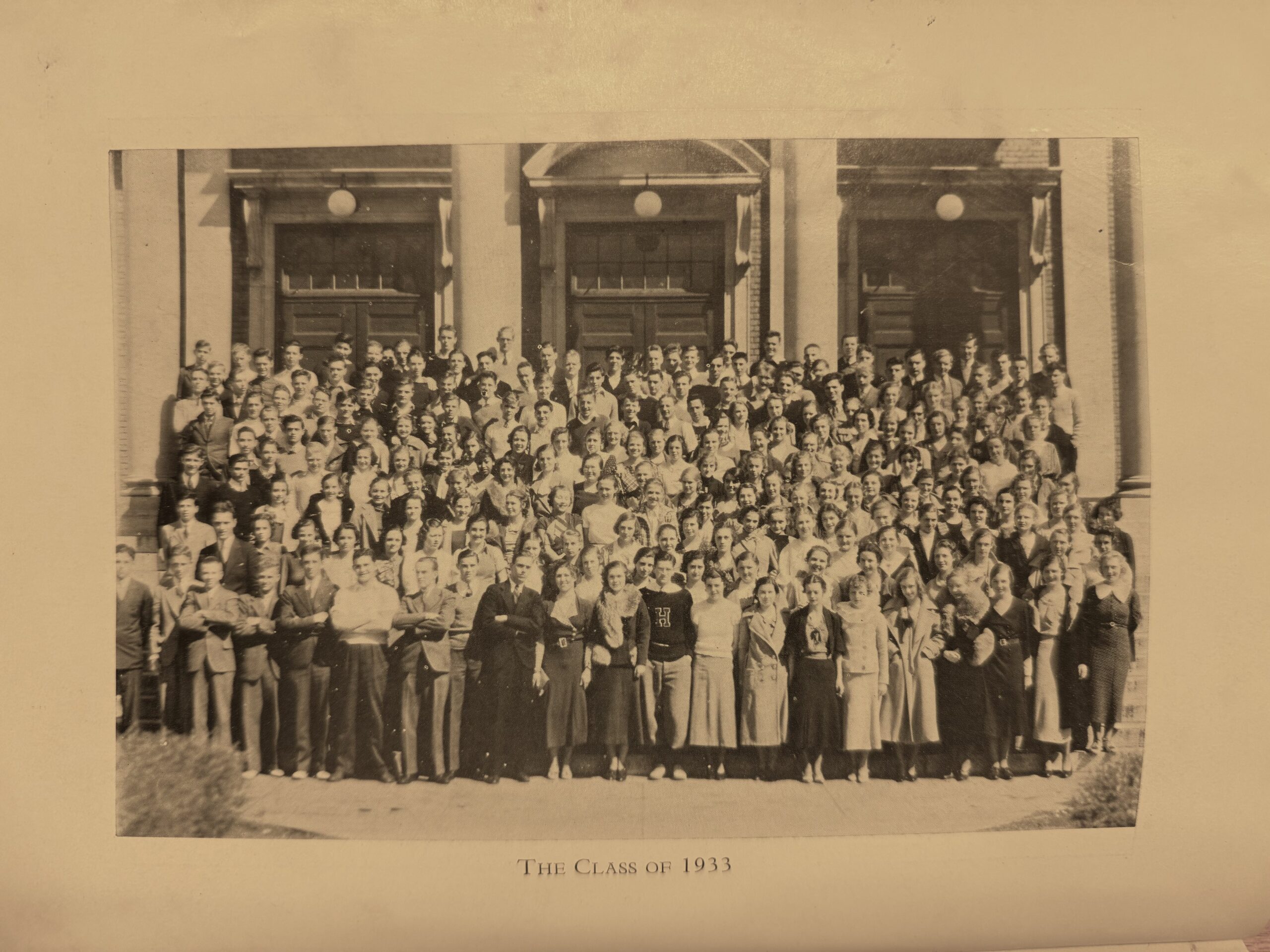
Hall High Yearbook, 1931. Courtesy of Local History Collection, West Hartford Public Library. Photo credit: Mia Jaworski
Twas the years of ‘thou,’ ‘doth,’ and drama – when West Hartford’s Hall High students filled their yearbooks with Shakespearean flair, opera performances, mysterious stamp clubs, Depression-era advice from the local bank, and prophecies imagining a world 10 years ahead.
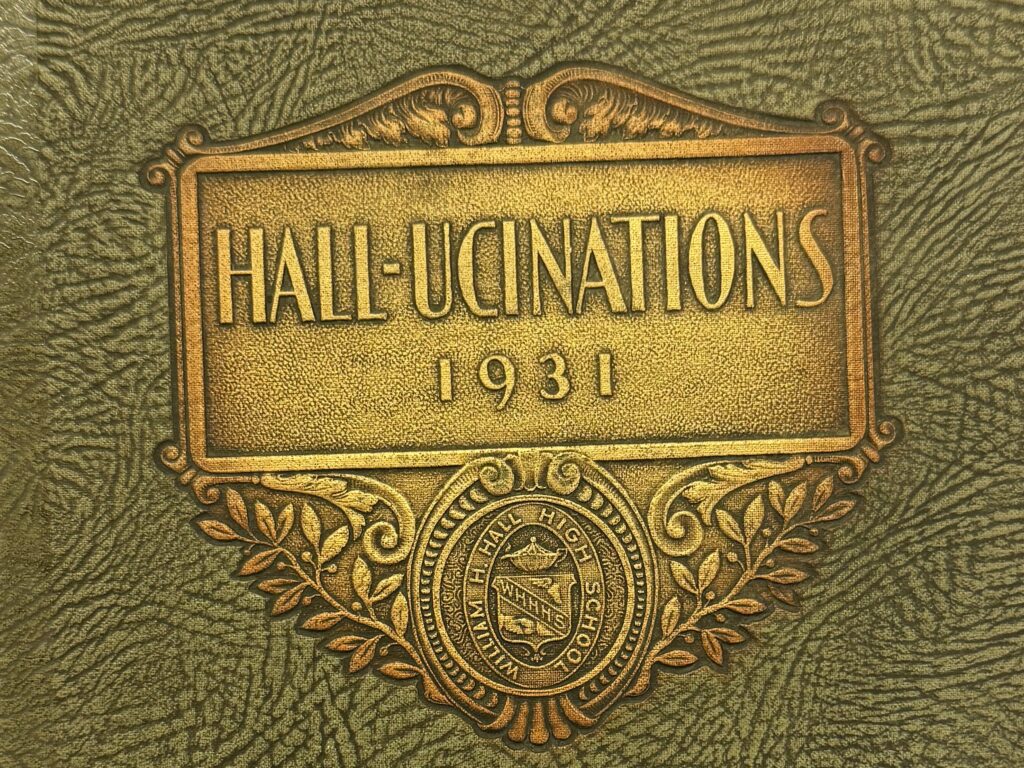
Cover of the 1931 Hall High yearbook, titled “Hall-ucinations.” Found in the Local History Collection, West Hartford Public Library. Photo credit: Mia Jaworski
By Mia Jaworski
Before the Beatles, before the bell bottoms, and decades before anyone dreamed of swirling colors and happy tunes, Hall High students in West Hartford crafted a cheeky, colorful record of teenage life that refused to let the Great Depression steal their fun.
Between 1931 and 1933, students at Hall High School gave their yearbooks a bold, playful name: Hall-ucinations.
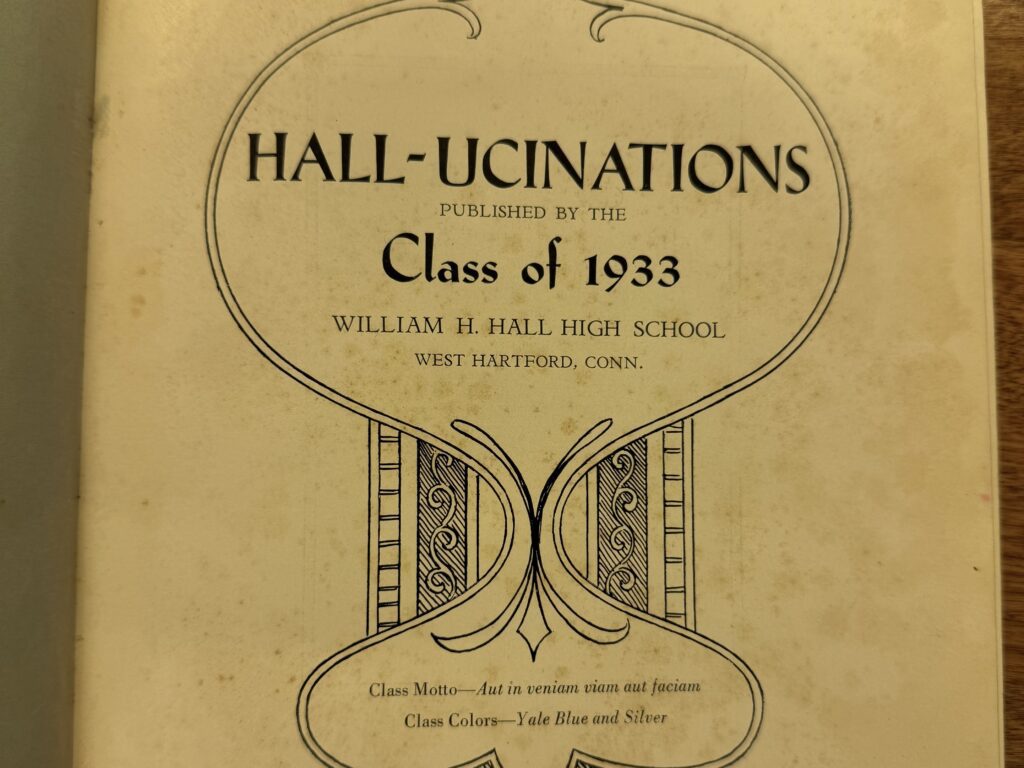
Hall High Yearbook, 1933. Courtesy of Local History Collection, West Hartford Public Library. Photo credit: Mia Jaworski
More than just a clever pun on the school name, it was an invitation to step inside a world where teenage rebellion met Shakespearean wit, and where ordinary felt delightfully quirky.
From mock-serious club portraits to unconventional “class stats” – where students were tagged with nicknames, ambitions, reputations, and even listed sins – the Hall-ucinations yearbooks capture a West Hartford crew who used humor and wild creativity to push back against the heavy shadow of the Great Depression.
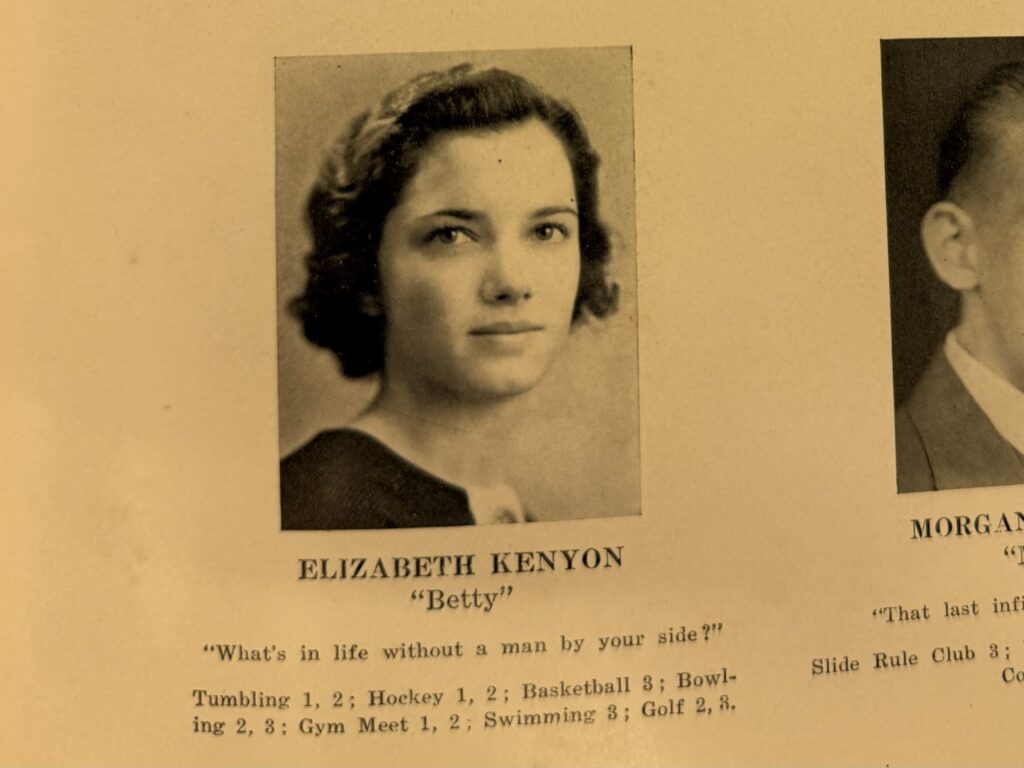
Hall High Yearbook Photo, 1933. Courtesy of Local History Collection, West Hartford Public Library. Photo credit: Mia Jaworski
Their senior quotes offer a window into a teenage world both theatrical and unfiltered – brash, gutsy and dripping with attitude:
“I came, I saw, she conquered.”
“I want to be bad.”
“If it will feed nothing else, it will feed our revenge.”

Hall High Yearbook photos, 1932. Photo credit: Mia Jaworski
Amidst the swagger, lies the lingo of the times – a world shaped by strict gender roles and old-fashioned ideas about love. And yes, it’s all in their yearbook.
“Give me three days to melt his fancy”
“I have immortal longings in me”
“All I ask is to be let alone – with someone.”
But beyond the lofty language and dramatic flair, the Class of 1933 confessed their senior regrets. That being: no beer in the cafeteria, the school’s phonograph blaring like a trumpet, the “kid” named depression that stole their athletic association and classmates who might’ve needed a little extra grooming (or mercy from the girls).
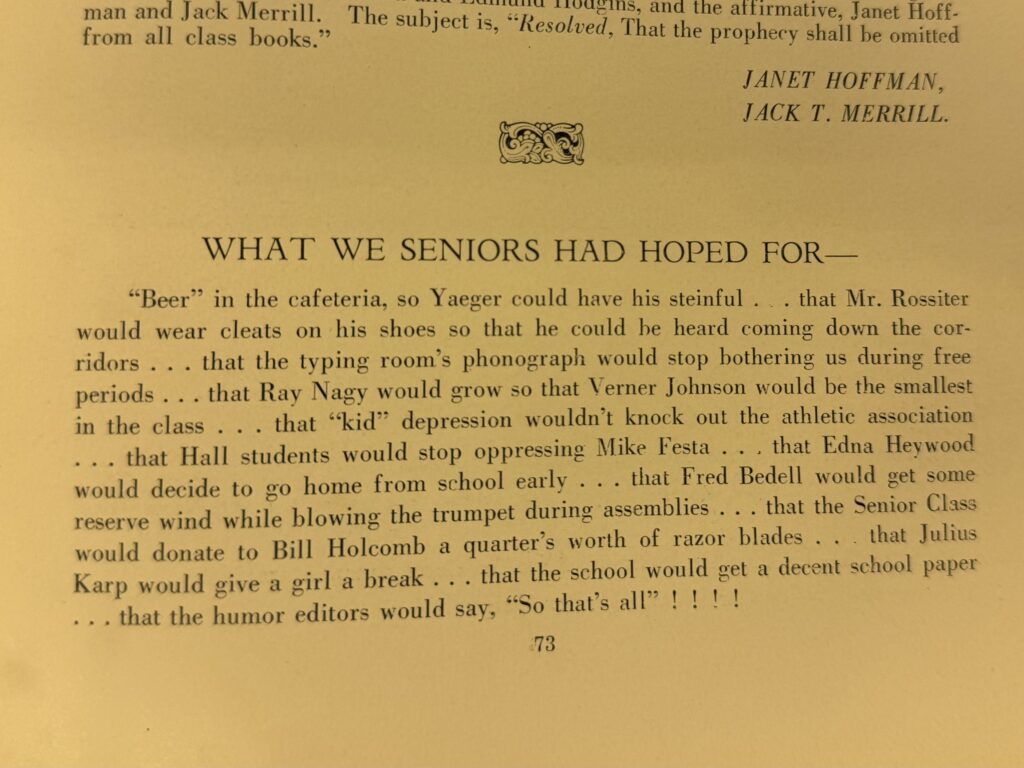
“What We Seniors Had Hoped For,” 1933. Photo credit: Mia Jaworski
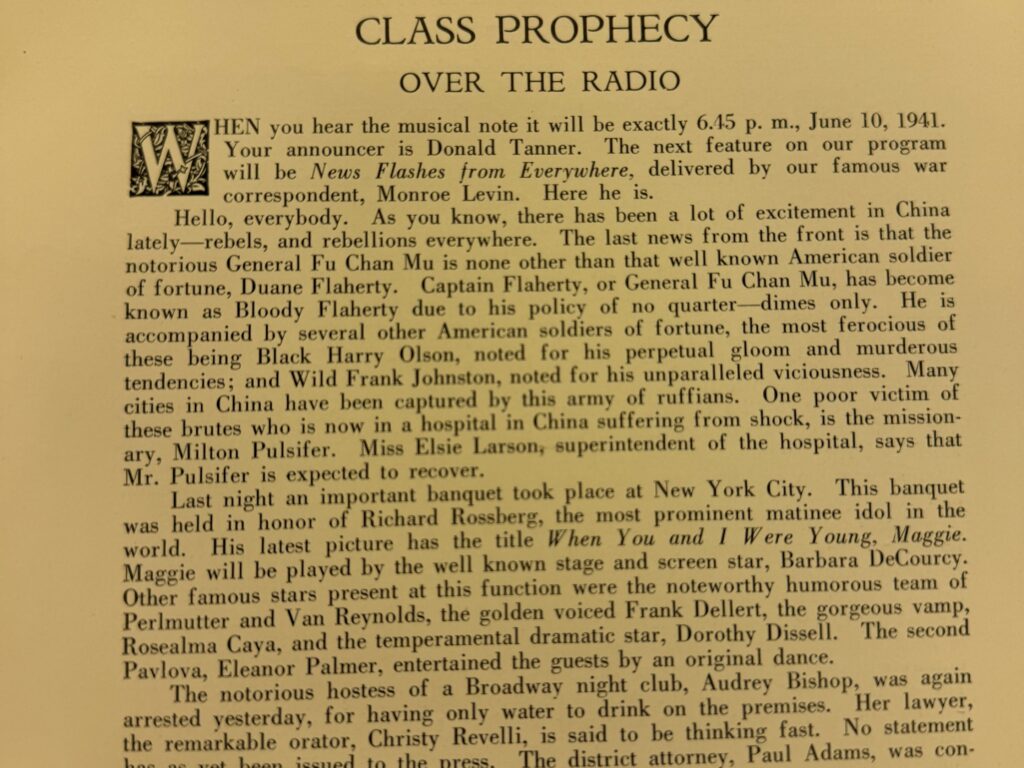
Class Prophecy, 1931. Photo credit: Mia Jaworski
In 1931, they sealed a time capsule filled with prophecies, dreams, and imagined futures set a decade ahead.
“When you hear the musical note it will be exactly 6:45 p.m., June 10, 1941. Your announcer is Donald Tanner…”
Through a mock radio newscast, they imagined classmates chasing careers, becoming stars, and living out bright futures – writing their own fairytale as a kind of hope against uncertainty.
“Last night an important banquet took place at New York City. This banquet was held in honor of Richard Rossberg, the most prominent matinee idol in the world.”
All of it – part whimsy, part wish – was laid down in the pages they hoped would outlast them. This faux radio newscast imagined a decade they had yet to enter – and a future that, unknown to them, would soon be reshaped by a world war.
“The Senate was in an uproar last night. The determination of the fiery Congresswoman, Grace Berekley, to hold the floor was seriously threatened by the determination of Senator Spencer Champlin to hold the floor himself. There was quite a tug of war.”
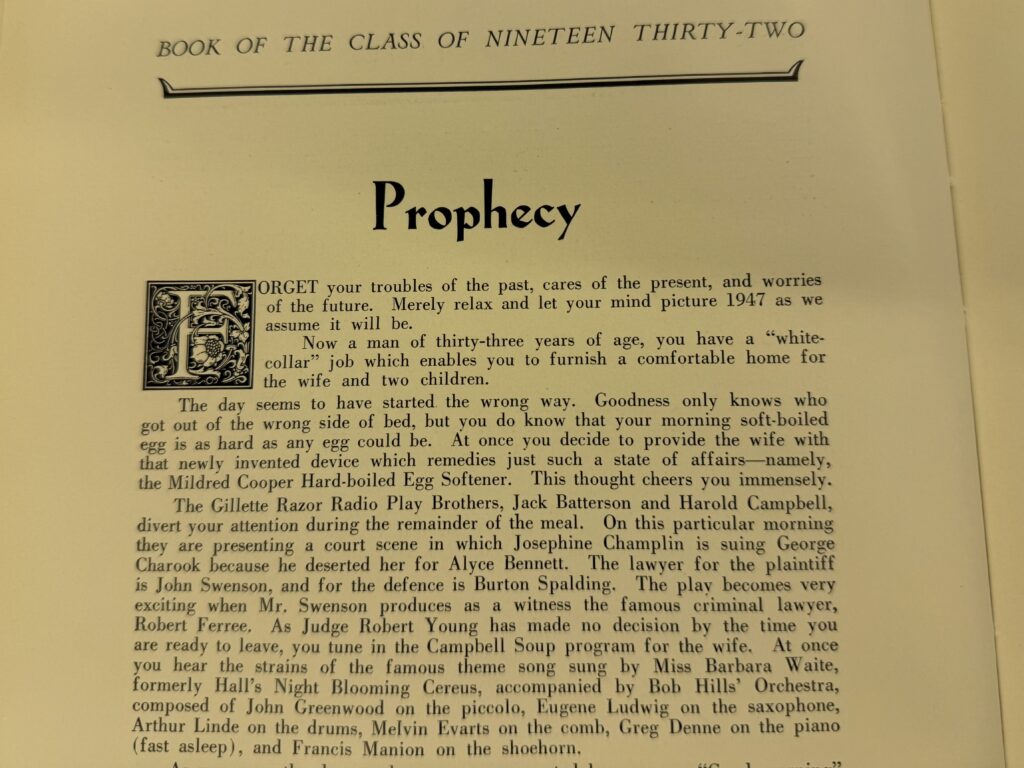
Class Prophecy, 1932. Photo credit: Mia Jaworski
The class of 1932 shared a different prophecy – one rooted in camaraderie and storytelling, a way to soothe the national nerves.
“Forget your troubles of the past, cares of the present, and worries of the future. Merely relax and let your mind picture 1947 as we assume it will be…”
(Hint: they may have not nailed their prediction)
Maybe their priorities were a little off-kilter – or they flourished in the mundane – these students imagined a future of getting out on the wrong side of bed and a soft-boiled egg left over the flame far too long to be called soft anymore.
The Hall-ucinations captured verbatim classroom jokes and the popular songs that made up the unofficial soundtrack of their high school years. Though true to form, even that list was full of puns, but are actual song titles from the late 1920/early 1930s.
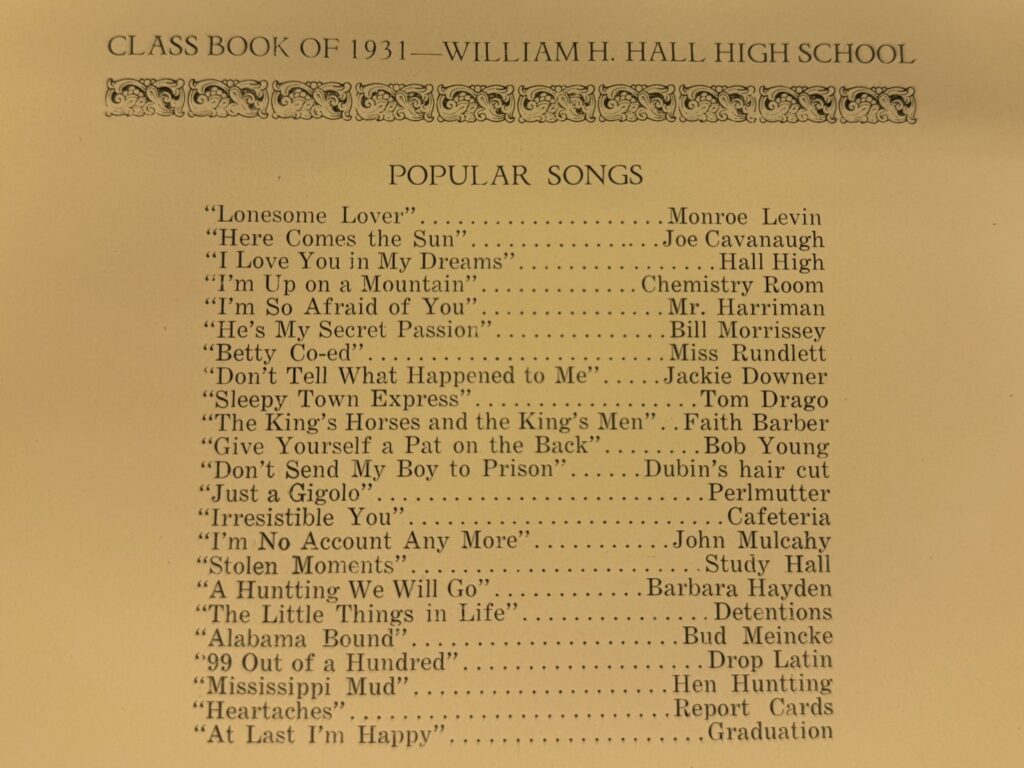
‘Popular Songs,’ 1931. Photo credit: Mia Jaworski
Irresistible You, sung by none other than the Cafeteria.
Heartaches by Report Cards.
Don’t Send My Boy To Prison inspired by Dubin’s hair cut.
I’m So Afraid of You, by a seemingly scary Mr. Harriman.
And another honorable mention:
At Last I’m Happy, sung by Graduation itself.
The pages included “simple” library rules like: “Make as much noise as possible,” “Carve your initials in the tables,” and “Never pass a book; always throw it.” Rules that, rumor has it, are still very much in effect today.
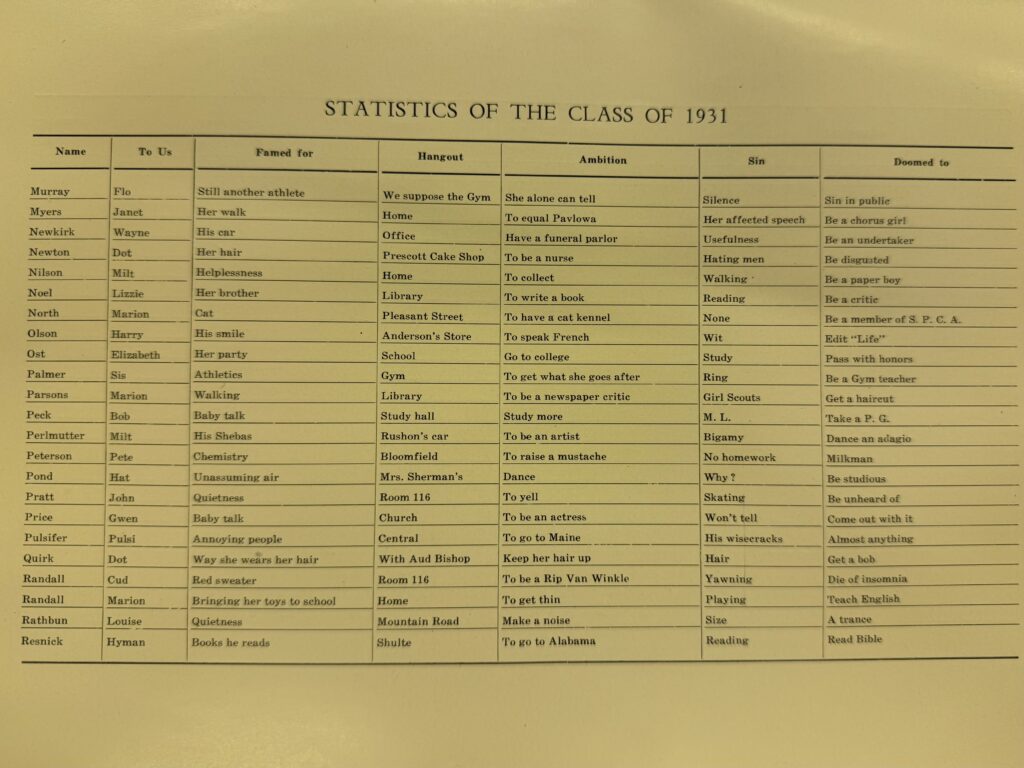
Class Statistics, 1931. A snapshot of student humor, reputations, and imagined futures — quirky trademarks of the Hall-ucinogenics style. Photo Credit: Mia Jaworski
Then came the “Class Statistics” – a- mash-up of a confessional booth, peer roast, and a life wish list. Students were “famed for” wisecracks, silence, or simply being “useful.”
Their ambitions swung from the practical – “to be a nurse” – to the peculiar – “to raise a mustache” or “own a funeral parlor.”
And their so-called sins? Entirely unserious – “bigamy,” “walking,” “Girl Scouts,” and the ever-mysterious “why?”
They even predicted their own downfalls – the lives they’d be doomed to lead. Chorus girl. Paper boy. Milkman. Bible-reader. All lined up like one big, running inside joke.
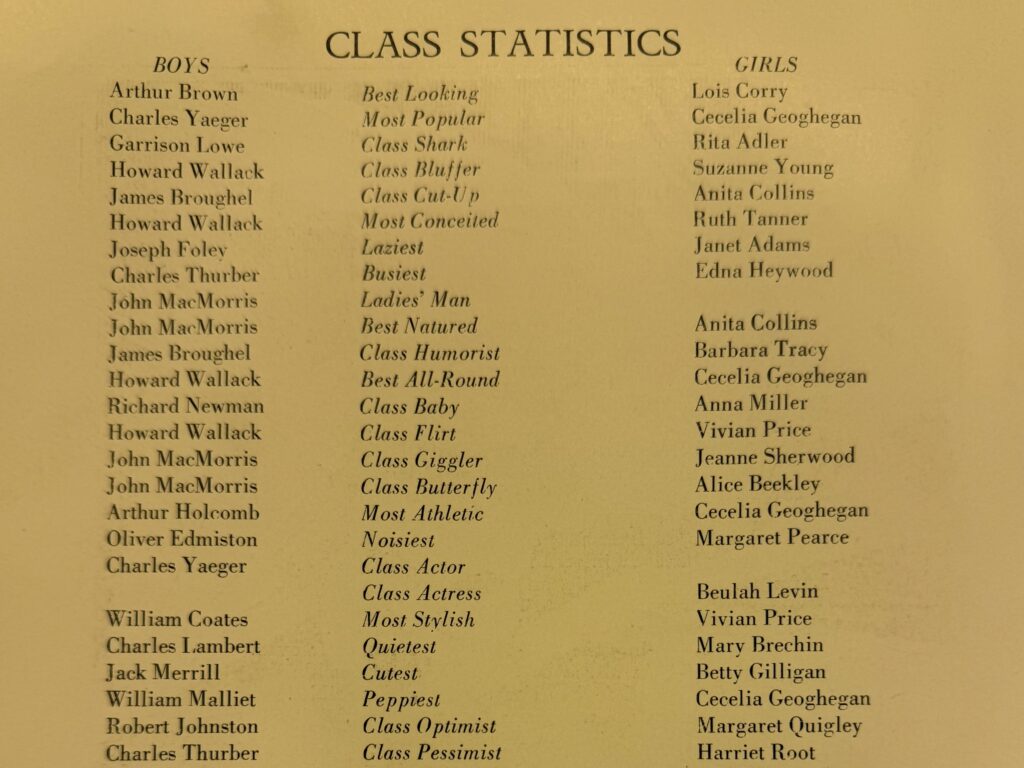
Class Statistics, 1933. Photo credit: Mia Jaworski
The yearbooks didn’t stop at inside jokes and stats. The pages featured comics – hand-drawn, black and white, and thick with Depression-era irony.
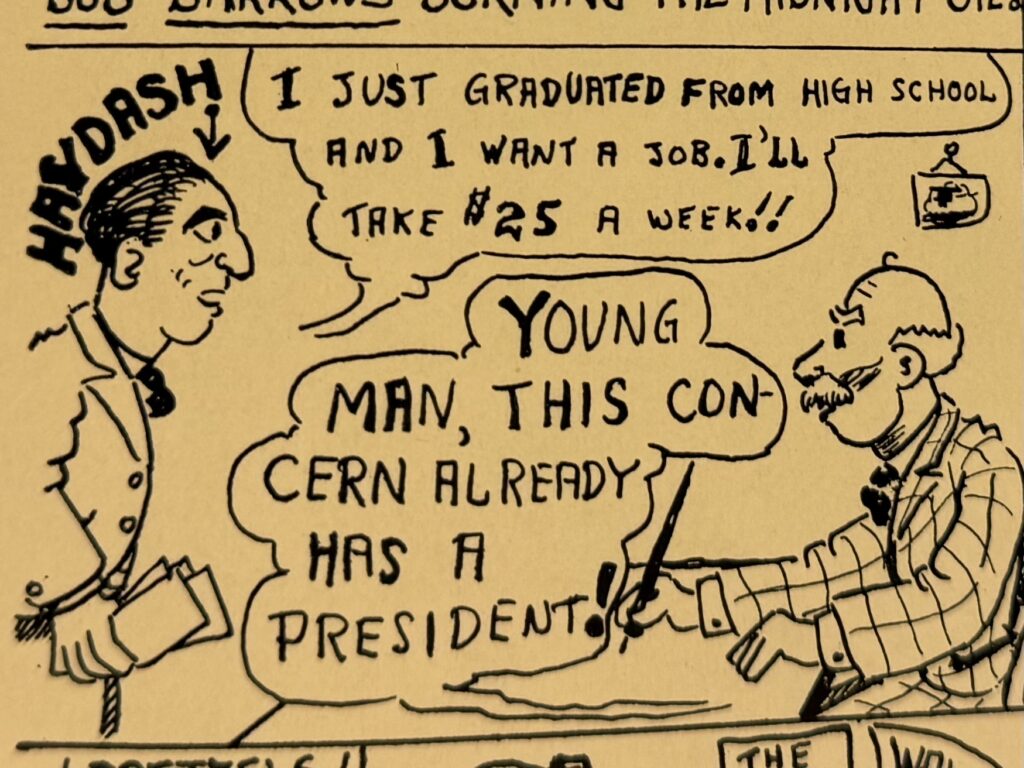
Haydash Comic, 1933 Hall High Yearbook, 1933. Courtesy of Local History Collection, West Hartford Public Library. Photo credit: Mia Jaworski
One standout strip features Haydash, a fresh high school graduate asking for a job, and a $25-a-week salary.
The reply? “Young man, this concern already has a president!”
It’s a punchline with 1930s bite – a reminder that in the depths of the Depression, asking for $25 a week sounded almost presidential.
Tucked into the 1933 class history is a brief note about an unexpected “prolonged vacation” their sophomore year – an epidemic of infantile paralysis that closed the school doors and left them reentering a full grade older.

1933 class history mentions a school closure due to an infantile paralysis epidemic — a reminder that students faced pandemic disruptions long before COVID-19. Photo credit: Mia Jaworski
A quiet reminder that even nearly a century ago, students were navigating disrupted school years and uncertain futures. Sound familiar?
Each book was dedicated to a teacher or lost friend – like Eric G. Norfeldt, who didn’t just get a mention, but eventually an entire elementary school named after him.
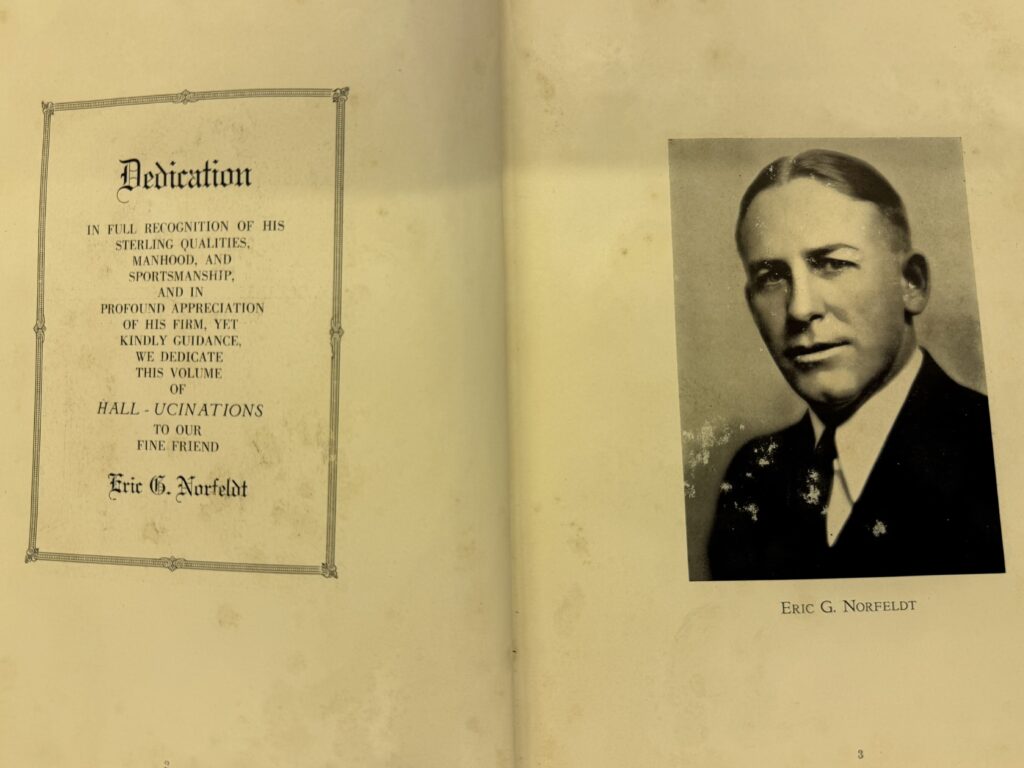
Dedication to Eric G. Norfeldt in the 1933 yearbook. Photo credit: Mia Jaworski
The yearbooks also spotlighted Hall High’s sports teams and clubs – from the “not a winner” basketball squad, the poetic musings of the Hall Idyllers, to the rifle club’s sharpshooters and the puzzling Stamp Club. A club that discouraged the passerby, where meetings turned Miss Hershey’s room into a fairground of stamp trading, guessing games, and lively discussions on new and rare releases.
- The Literary Club, Hall High Yearbook, 1932. Courtesy of West Hartford Archives. Photo credit: Mia Jaworski
- The Hall Players, Hall High Yearbook, 1931. Courtesy of West Hartford Archives. Photo credit: Mia Jaworski
- The Debating Club Hall High Yearbook, 1931. Courtesy of West Hartford Archives. Photo credit: Mia Jaworski
- The Chess Club, Hall High Yearbook, 1931. Courtesy of West Hartford Archives. Photo credit: Mia Jaworski
- The Art Club, Hall High Yearbook, 1931. Courtesy of West Hartford Archives. Photo credit: Mia Jaworski
- Band and Orchestra, Hall High Yearbook, 1931. Courtesy of West Hartford Archives. Photo credit: Mia Jaworski
- The Opera Club, Hall High Yearbook, 1931. Courtesy of West Hartford Archives. Photo credit: Mia Jaworski
- 1931 Hall Baseball team. Photo credit: Mia Jaworski
- Hall 1931 Ice Hockey Team. Photo Credit: Mia Jaworski
- Hall 1931 Basketball team. Photo credit: Mia Jaworski
- Hall 1933 Soccer Team. Photo credit: Mia Jaworski
- Hall 1933 Rifle Club. Photo credit: Mia Jaworski
- Hall Girl’s Basketball and Hockey teams, 1931. Photo credit: Mia Jaworski
- Hall 1932 Baseball team. Photo credit: Mia Jaworski.
- Hall Tumbling Team, 1933. Photo credit: Mia Jaworski
- Hall 1933 Tennis team. Photo credit: Mia Jaworski
- Hall Girl’s Leaders Club, 1933. Photo credit: Mia Jaworski
- Hall Girl’s Hockey team, 1933. Photo credit: Mia Jaworski
Amid all this vibrant student life and spirited creativity, the yearbooks also carried a very real reminder of the times – local businesses pitching their wares and services, displaying the everyday reality of 1930s West Hartford.
These ads weren’t just commercial fillers; they were lifelines in a decade when every dollar counted. From the West Hartford Trust Company offering advice on building credit to the beloved A.C. Petersen proudly promoting their milk, they reflected everyday needs and comforts.
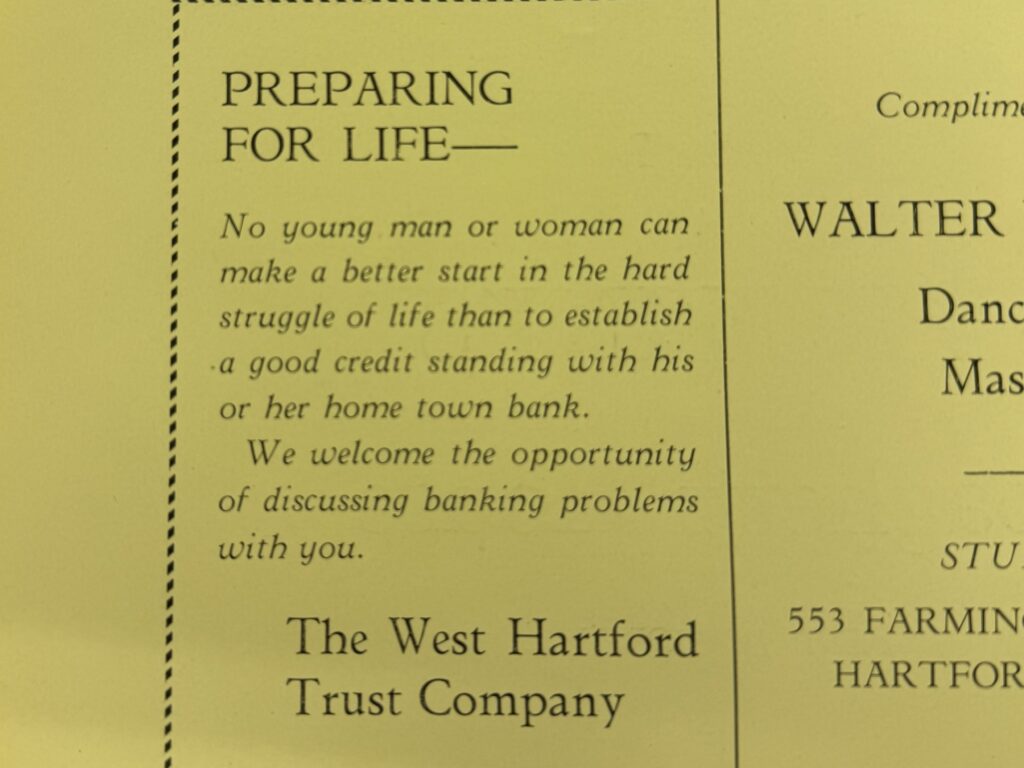
An ad from the West Hartford Trust Company encouraged students to start “preparing for life,” offering Depression-era advice, 1931. Photo credit: Mia Jaworski
There was “A Royal Smoke,” a cigar ad hinting at a touch of luxury, and P. Putini’s Spaghetti House, promising a taste of home-cooked warmth. Typewriters priced at $6.50, local barber shops, ash collectors, and even the children’s museum – now a memory itself – rounded out a snapshot of daily life in Depression-era West Hartford.
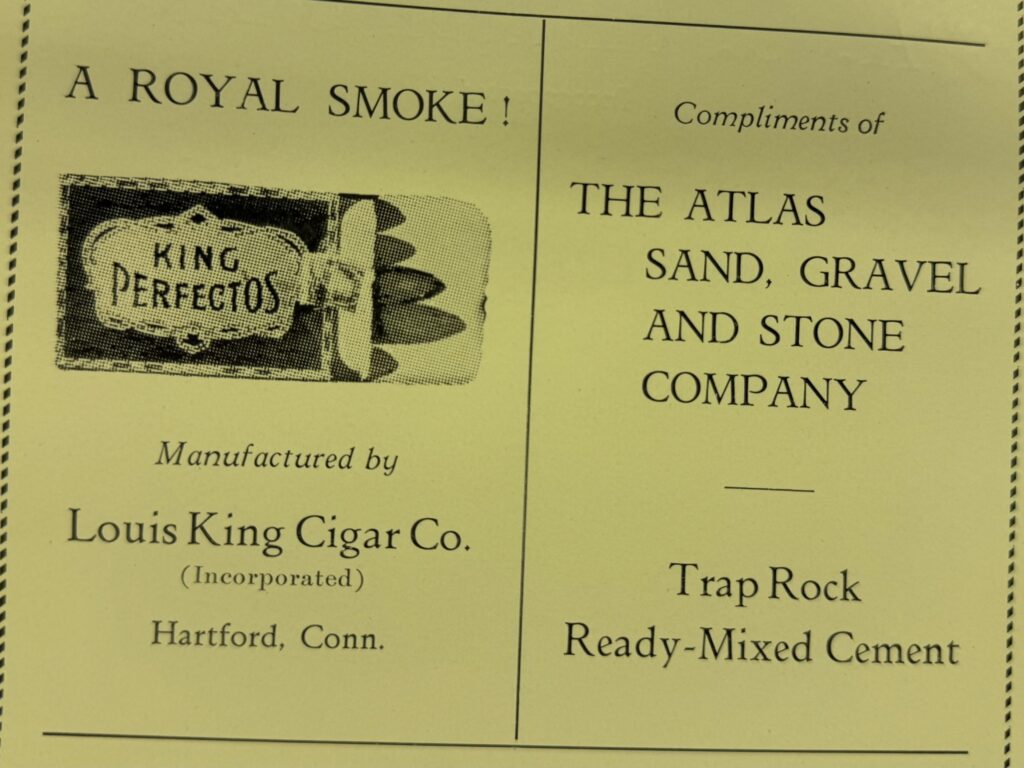
Louis King Cigar Co. Ad in 1933 Hall yearbook. Photo credit: Mia Jaworski
Before closing the book, the 1932 humor editors left a deliberately exaggerated and cheerful message for their classmates. Written in a playful, folksy tone, they made sure to remind everyone that everything inside was meant in good fun – a lighthearted send-off that echoes the humor and spirit that runs throughout their yearbook.
These captivating yearbooks were uncovered at the West Hartford Archives, Local History Collection, West Hartford Public Library. The local archives are open Mondays from noon to 6 p.m., Wednesdays from 2 to 8 p.m., Fridays from 10 a.m. to 2 p.m., and on the first and third Saturdays of each month from 10 a.m. to 2 p.m.
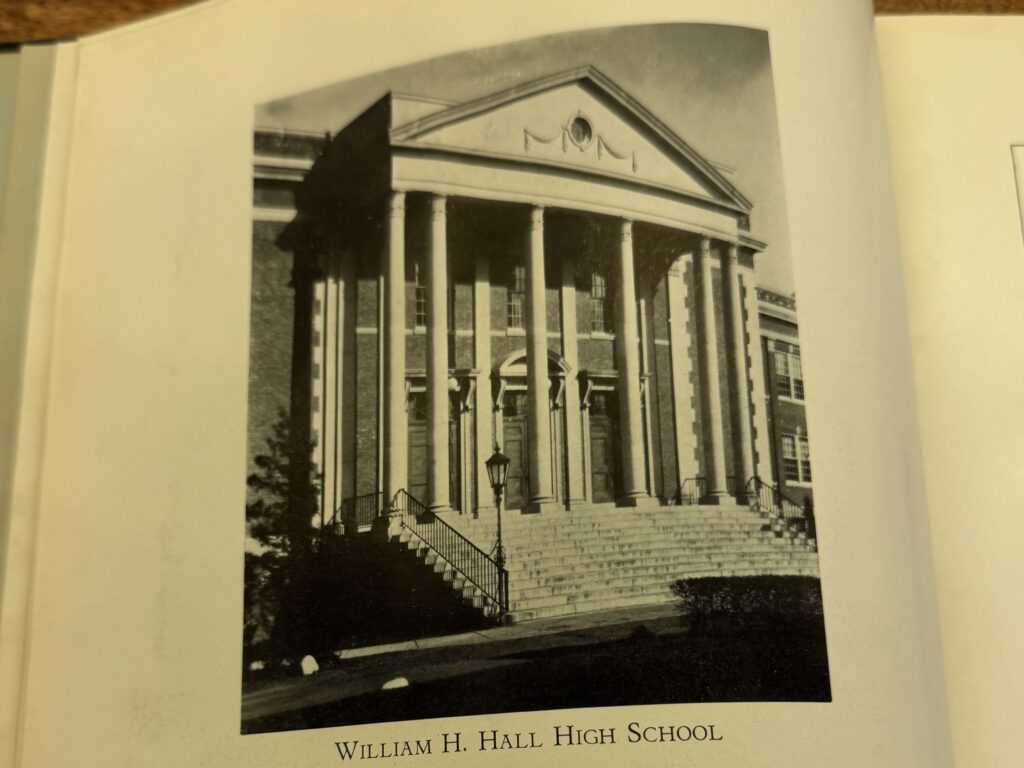
William H. Hall High school, Hall-ucinations yearbook, 1932. Photo credit: Mia Jaworski
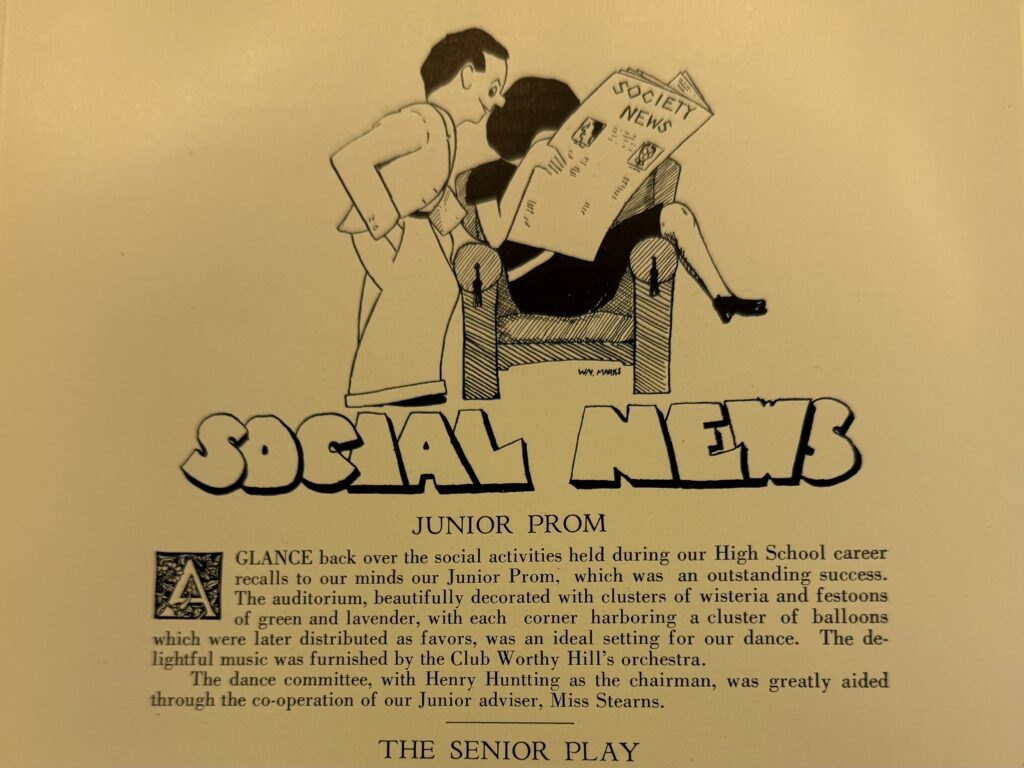
Hall High Yearbook, 1931. Courtesy of Local History Collection, West Hartford Public Library. Photo credit: Mia Jaworski
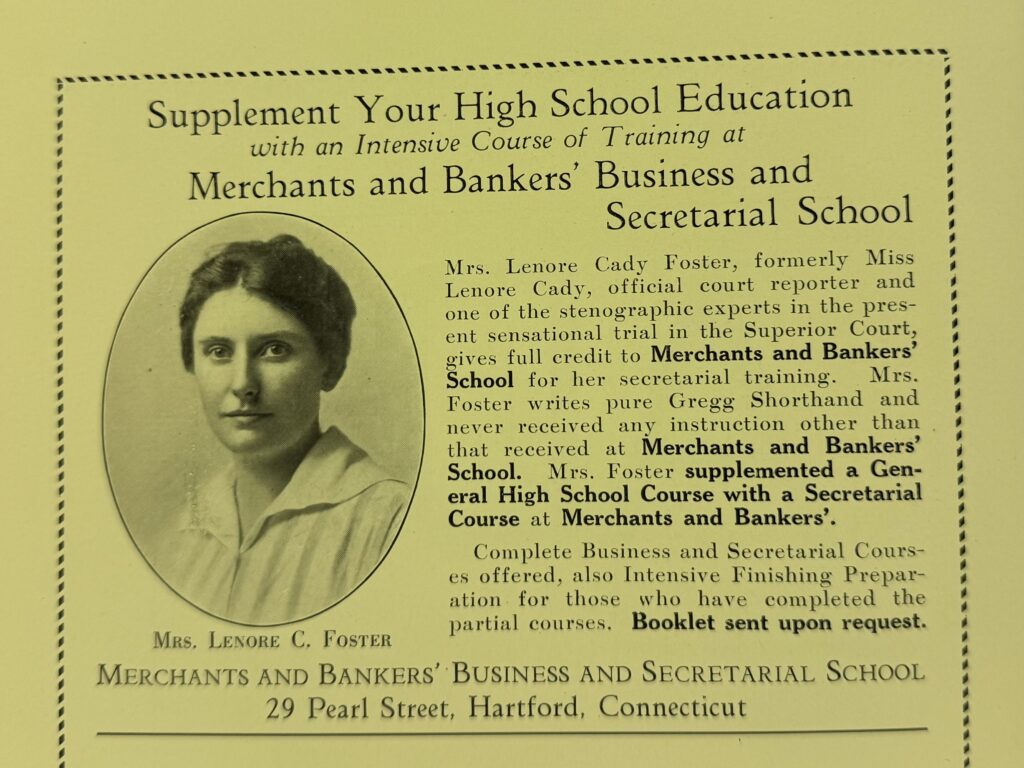
Courtesy of Local History Collection, West Hartford Public Library. Photo credit: Mia Jaworski
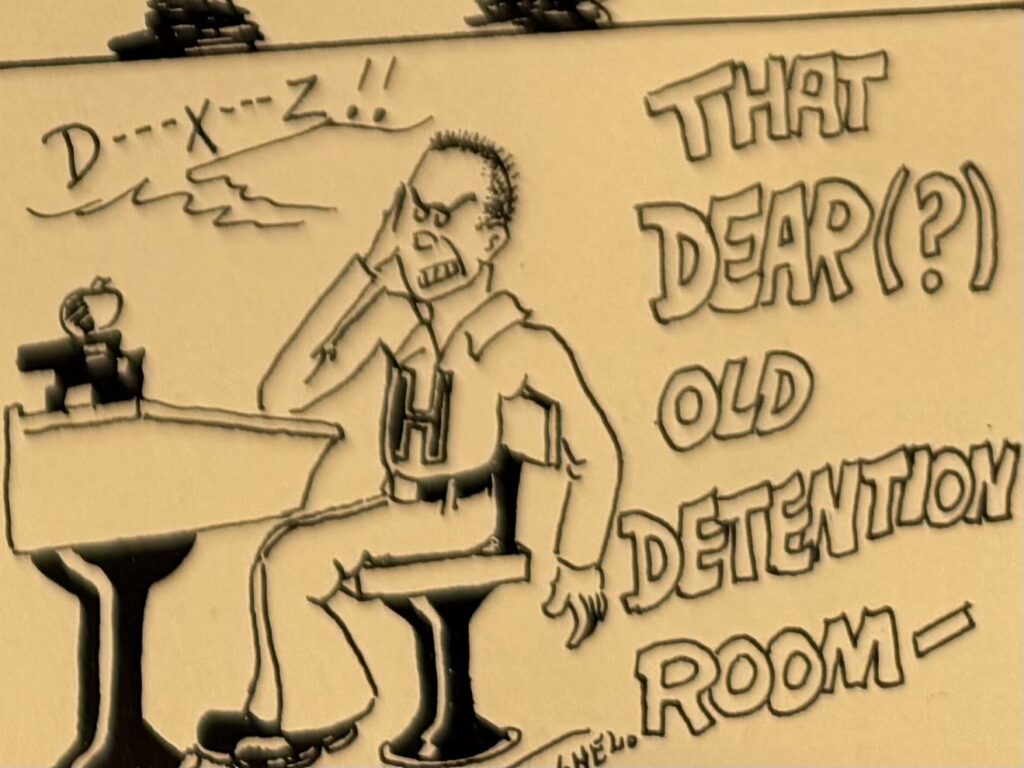
Hall High Yearbook, 1932. Courtesy of Local History Collection, West Hartford Public Library. Photo credit: Mia Jaworski
Like what you see here? Click here to subscribe to We-Ha’s newsletter so you’ll always be in the know about what’s happening in West Hartford! Click the blue button below to become a supporter of We-Ha.com and our efforts to continue producing quality journalism.





















